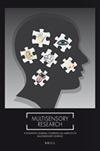触觉流对视觉头球感知的影响。
IF 1.5
4区 心理学
Q3 BIOPHYSICS
引用次数: 1
摘要
整合来自不同感觉模式的信息对于在环境中成功导航至关重要。除其他外,自我运动在视网膜上诱导不同的视觉流模式、前庭信号和触觉流,这有助于确定行进距离(路径积分)或运动方向(航向)。虽然对组合视觉前庭信息的处理受到越来越多的文献的关注,但在自我运动的背景下对视觉触觉信号的处理却相对较少受到关注。在这里,我们研究了视觉航向感知是否受到与行为无关的触觉流的影响。在视觉模态中,我们模拟了观察者在水平地平面上的自我运动(光流)。触觉自运动刺激由头戴式喷嘴的气流(触觉流)提供。在一组组试验中,我们只提供视觉或触觉刺激,受试者必须报告他们感知到的航向。在另一组试验中,触觉和视觉刺激同时出现,触觉流在视觉航向的±40°范围内(双峰条件)。在这里,重要的是,参与者必须报告他们感知到的视觉方向。在所有条件下感知到的自运动方向都显示出向心偏差,即航向方向被感知为朝着直行方向压缩。在双峰条件下,我们发现与任务无关的触觉流对视觉感知标题的影响很小,但有系统性,这是其方向偏移的函数。我们得出的结论是,触觉流与自我运动感知的联系比以前认为的更紧密。本文章由计算机程序翻译,如有差异,请以英文原文为准。
Influence of Tactile Flow on Visual Heading Perception.
The integration of information from different sensory modalities is crucial for successful navigation through an environment. Among others, self-motion induces distinct optic flow patterns on the retina, vestibular signals and tactile flow, which contribute to determine traveled distance (path integration) or movement direction (heading). While the processing of combined visual-vestibular information is subject to a growing body of literature, the processing of visuo-tactile signals in the context of self-motion has received comparatively little attention. Here, we investigated whether visual heading perception is influenced by behaviorally irrelevant tactile flow. In the visual modality, we simulated an observer's self-motion across a horizontal ground plane (optic flow). Tactile self-motion stimuli were delivered by air flow from head-mounted nozzles (tactile flow). In blocks of trials, we presented only visual or tactile stimuli and subjects had to report their perceived heading. In another block of trials, tactile and visual stimuli were presented simultaneously, with the tactile flow within ±40° of the visual heading (bimodal condition). Here, importantly, participants had to report their perceived visual heading. Perceived self-motion direction in all conditions revealed a centripetal bias, i.e., heading directions were perceived as compressed toward straight ahead. In the bimodal condition, we found a small but systematic influence of task-irrelevant tactile flow on visually perceived headings as function of their directional offset. We conclude that tactile flow is more tightly linked to self-motion perception than previously thought.
求助全文
通过发布文献求助,成功后即可免费获取论文全文。
去求助
来源期刊

Multisensory Research
BIOPHYSICS-PSYCHOLOGY
CiteScore
3.50
自引率
12.50%
发文量
15
期刊介绍:
Multisensory Research is an interdisciplinary archival journal covering all aspects of multisensory processing including the control of action, cognition and attention. Research using any approach to increase our understanding of multisensory perceptual, behavioural, neural and computational mechanisms is encouraged. Empirical, neurophysiological, psychophysical, brain imaging, clinical, developmental, mathematical and computational analyses are welcome. Research will also be considered covering multisensory applications such as sensory substitution, crossmodal methods for delivering sensory information or multisensory approaches to robotics and engineering. Short communications and technical notes that draw attention to new developments will be included, as will reviews and commentaries on current issues. Special issues dealing with specific topics will be announced from time to time. Multisensory Research is a continuation of Seeing and Perceiving, and of Spatial Vision.
 求助内容:
求助内容: 应助结果提醒方式:
应助结果提醒方式:


